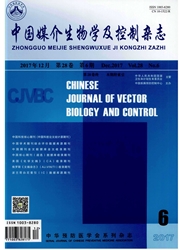

 中文摘要:
中文摘要:
目的 了解滇西南家鼠鼠疫疫源地小兽及寄生蚤在不同景观的分布特征和规律,以及与鼠疫流行的关系。方法 以滇西南云县、永德、景谷、宁洱、勐海和勐腊6个县为调查对象,运用群落生态学指标对小兽及其寄生蚤类多样性的空间分布特征进行研究。结果 本次调查共捕获小型兽类719只,隶属3目6科12属19种(亚种)。黄胸鼠(55.77%)为优势鼠种;共收集蚤类229匹,隶属5科11属14种(亚种),印鼠客蚤(57.21%)和泸水栉眼蚤(17.03%)为优势种。不同景观小型兽类及其寄生蚤类多样性指数和均匀度指数从高到低依次为林区〉 农耕地〉 居民区,而优势度指数则相反的空间分布格局。林区、农耕区和居民区捕获小兽的物种多样性指数分别为2.28、1.60和0.16;林区、农耕区和居民区捕获的小兽寄生蚤物种多样性指数分别为1.97、1.75和0.15。结论 林区景观有利于维持家鼠鼠疫疫源地的自然疫源性,居民区景观是鼠疫流行的重要环境,农耕区可能是鼠疫传播和流行的重要通道,在家鼠型鼠疫疫源地长期保存、流行和扩散机制中有关键作用。
 英文摘要:
英文摘要:
Objective To investigate the distribution features and laws of small mammals and ectoparasitic fleas in different landscapes in domestic rat plague foci in Southwest Yunnan and their relationship with plague prevalence. Methods Yunxian, Yongde, Jinggu, Ninger, Menghai and Mengla were sampling area of our research. The systematic investigation on small mammals and their ectoparasitic fleas distributed in different landscape ecosystem were carried out. The characteristics of the spatial distribution of diversity of small mammals and their ectoparasitic fleas were analyzed using community ecological indexes. Results There were 719 small mammals captured, which belonged to 19 species (subspecies), 12 genera, 6 families and 3 orders. Rattus tanezumi (55.77%) were dominant species. A total of 229 fleas were captured, and they were classified into 14 species (subspecies) of 11 genera in 5 families. Xenopsylla cheopis (57.21%) and Ctenophtha lmus lushuiensis (17.03%) were dominated species. Diversity index and evenness index of small mammals and ectoparasitic fleas in different landscapes was, in descending order, forest area〉 agricultural area〉 residential area. But the order of dominance index was opposite. Shannon-Wienne's diversity index(H') of small mammals captured in forest area, agricultural area and residential area was 2.28, 1.60 and 0.16 respectively, and that index of ectoparasitic fleas was 1.97, 1.75 and 0.15 respectively. Conclusion Landscape played a dominant role in community structure of host animals and fleas. Forest area helped to keep natural focus in domestic rat plague foci. Residential area was an important environment of plague prevalence. Agricultural area might be an important channel of transmission and prevalence of plague. Agricultural area played a pivotal role in long-term preservation, prevalence and diffusion of domestic rat plague foci.
 同期刊论文项目
同期刊论文项目
 同项目期刊论文
同项目期刊论文
 期刊信息
期刊信息
